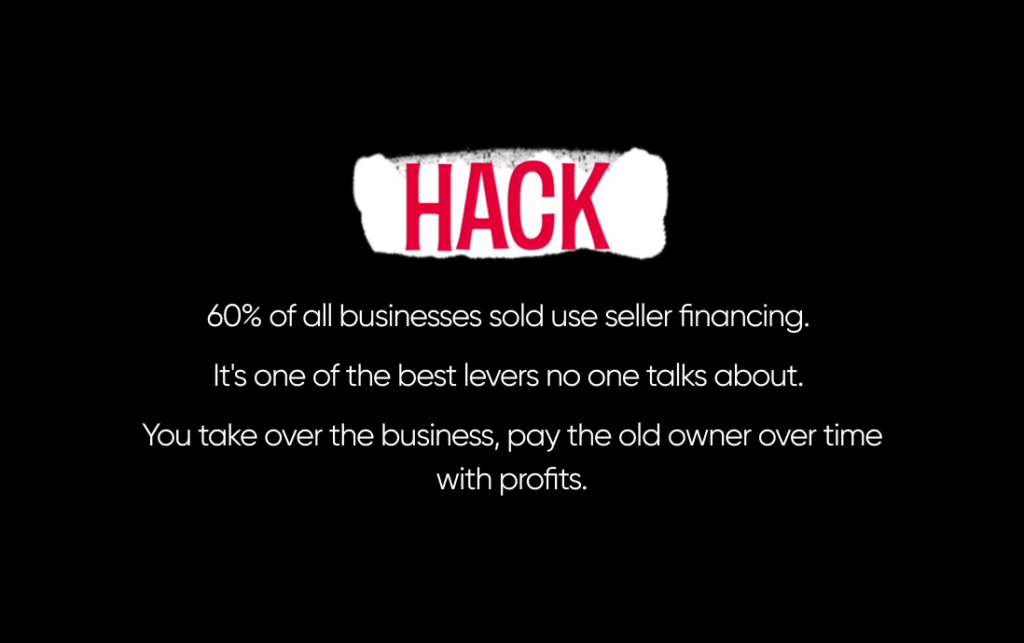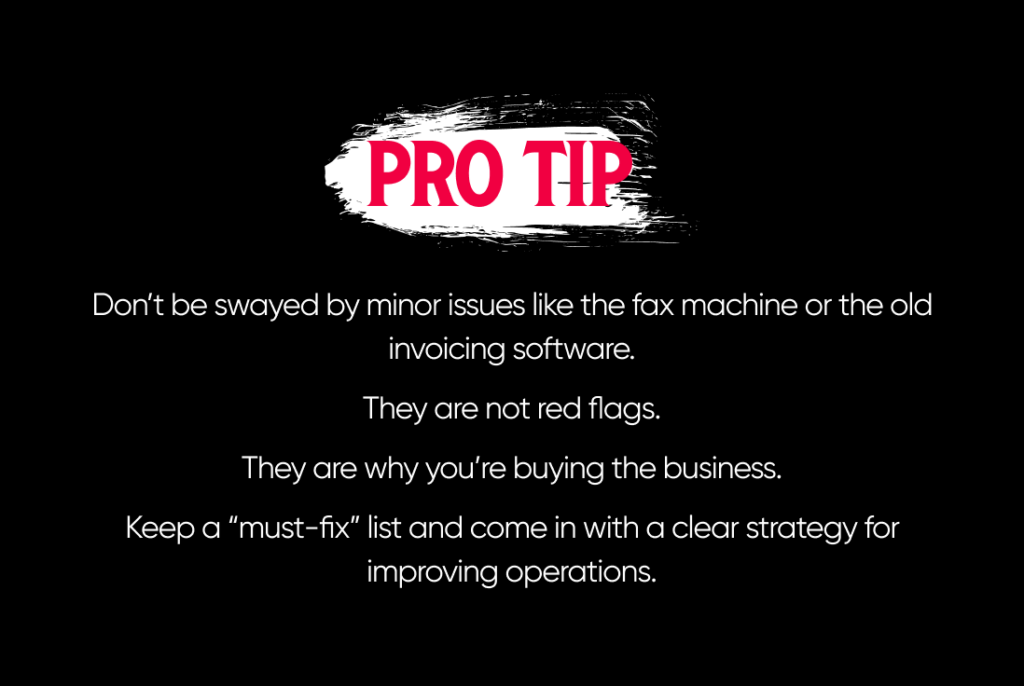
Buying someone else’s business is the fast lane to becoming an entrepreneur. It also reduces your risks compared to starting one since a proven business offers you a strong foundation to scale.
Most people think of personal assets and savings, investors, partners, and business loans as the only way to buy a business from someone else.
But what if:
- You don’t have sufficient funds to pay out of pocket?
- You can’t get competitive interest rates from traditional bank loans?
- You don’t want to deal with the pain-in-the-ass aspects of traditional financing methods?
Enter seller financing.
Buying a business with seller financing is the best way to take over a company. With a seller-financed deal, you get an established business with a strong foundation. And you get it on terms that are a win-win for you and the previous owner.
Here’s what you need to know if you want to buy a business with seller financing.
A Quick Recap of Seller Financing

Buying a business with seller financing isn’t so different from the concept of taking out a business loan or bank loan.
Except seller financing:
- Offers much more flexibility and customization.
- Doesn’t require you to take a big ding on your credit report.
- Doesn’t put you at risk of a bank denying you funding due to a low credit score.
- Doesn’t put you under the thumb of traditional lenders’ strict repayment terms.
Other than that, seller financing uses the previous owner like a bank.
You come to terms with the previous owner where they transfer the business to you. In most cases, you pay them a small down payment (though there are cases where you can buy a business for no money down).
Then you pay the old owner back over a set period from the revenue you make.
But there’s 1 downside to seller financing.
Most people don’t know about it. Buyers don’t bring it up to sellers. And, if a buyer does know about it, they still need to educate the seller on it before negotiating a deal.
You’ll put yourself in a strong business buying position if you educate yourself about this form of financing. If you can show a seller why this kind of deal is a win-win, then you’ve set yourself up with the best way to a business.
Don’t believe it’s possible? Check out Hannah’s story.
She bought her first car wash for $140k. Oh yeah, and she did it with $0 down. Here’s how she made seller financing work for her:
Seeing all the potential with seller financing? Want to do it yourself? Follow these steps to make the deal happen.
1. Find a Business That’s Worth Buying
Seller financing only works when you find a business that’s worth investing in. It has to have cashflow so you can afford to pay the seller out of your revenue stream.
The good news is that great business opportunities are all around you once you know what to look for.
Use our SOWS framework to find a business worth buying. That means the business hits on each of these four concepts:
- Stale: It uses outdated tech or hasn’t innovated.
- Old: It’s been operational for a long time.
- Weak: The competition can’t keep up if you modernize.
- Simple: It follows a simple business model.
The basic rules of buying a good business call on you to suss out right away what’s working and what’s stale, old, or weak. A simple business model may not be sexy, but it’s also the very essence of boring but profitable companies like laundromats, car washes, and vending machine empires.
Look for companies that need a little tweaking in your area of expertise. For example, maybe the business functions fine but could really use an infusion of operational expertise that you bring to the table.
Once you know what you’re looking for, follow these steps to find good opportunities:
- Lay out your personal goals. How involved do you plan to be in the new business? What kind of model appeals to you?
- Set aside time on your calendar and dedicate it to searching for the right business.
- Look on marketplaces like Flippa or BizBuySell to find businesses that are on sale.
- Use networking or BizScout to find off-market deals. Full disclosure: BizScout is a tool we own and maintain to help entrepreneurs find their next business.
- Create your shortlist of businesses you’re interested in.
- Talk to the owners of the businesses on your shortlist to help narrow things down and get a feel for what it would be like to own their business.
P.S. If you’re still having trouble and want a deep dive into the search for acquisition opportunities, check out our full breakdown on how to find a business to buy.
2. Send a Letter of Intent
You’ve created your shortlist. You’ve talked to the owners. By this point, you’ve found a business that seems promising.
Now it’s time to get down to business by sending the owner a letter of intent.
A letter of intent tells the current owner that you’re serious about buying their company.
This document is a sign of good faith to the owner. It’s not a binding agreement stating you guarantee that you’ll buy the business. It’s just a way to show the owner your preliminary commitment to do business with them.
When the owner accepts your letter of intent, you’ll have the opportunity to review in-depth financial details about the business.
3. Evaluate the Business
Whatever you do, do not speed through the due diligence process.
This is where good deals can easily go wrong. Spend the time combing through all the information you get from the owner so you feel completely confident in your decision to move forward.
Here’s what to keep in mind during this evaluation phase:
- Get professional outside appraisals of any physical assets, including real estate or equipment.
- Match profit/loss statements, bank statements, and tax returns. They should all tell the same story.
- Make a list of all the problems you identify, including anything that will require total replacement. This will help you make your final decision to buy or not, but will also position you well to make a competitive offer with all the data in mind.
As you go through this process, you will find things you don’t like.

The key? Don’t be swayed by minor issues.
It’s good to know you have minor issues, such as needing new invoicing software. That just means you’re buying a business that fits the SOWS framework.
Don’t misclassify these as red flags.
Instead, look for things you can’t live with during due diligence. Find your red flags so you know when to walk away from a deal.
Keep note of everything else you find so you can prioritize your “must fix” list. This will strengthen your negotiating position later.
4. Educate the Owner About Seller Financing
Some sellers don’t understand seller financing. They don’t know why it works to their benefit.
It’s your job to show them if you want this kind of deal.
Many sellers might consider an all-cash sale their dream. They get the money and can walk away from their business. But most of them also know that the pool of potential buyers shrinks when they limit themselves to this.
In other words, most sellers are open to alternative financing. You just have to convince them.
When you introduce it the right way, seller financing benefits both parties.
The seller gets paid for their business over time instead of in a lump sum. This means you’re both invested in the continued success of the company.
When you calculate interest into the deal, the seller could even make more money out of it.
Some business owners remain committed to getting their ideal purchase price when selling. Depending on the current market conditions, that might be unrealistic for them.
But a seller-financed deal can give them the full price they want—just not all at once. It also helps you by spreading your payments over a set period of time.
Use all of these facts as talking points to educate the seller and convince them that it’s a win-win.
5. Start Structuring Your Deal

You’ve convinced the business owner that seller financing is the way to go.
Now it’s time to negotiate.
Come to the negotiating table with a plan to compromise. It’s unlikely that you’ll get everything you want in your first offer, but the same goes for the seller.
Use everything that you found in your evaluation of the business as ammunition in negotiation.
The business uses outdated operations software? Equipment needs to be replaced? Their prices haven’t kept up with the market rate?
All of those things will cost you time and capital to fix. It’s only fair to present reasonable terms that take your improvement costs into consideration.
Before drawing up an agreement, think over your own proposal and deal breakers on the following issues.
- Down payment: How much can you or will you pay to close on the sale?
- Loan terms: How long will it take you to pay back the owner?
- Interest rate: What annual rate of interest will the seller receive on the note? Is this fixed or variable?
- Guarantees: What security does the seller have to receive their money?
It might take a few rounds before you and the owner can come to an agreement. But when you get these 4 things out of the way, you’re one step closer to ownership.
6. Close the Deal
All your hard work up to this point pays off when you close the deal.
But that’s also where the hard work of running the business begins.
In the first 90 days, you need to tackle a few things:
- Transferring the business into your name, including any accounts, vendor contracts, licenses, and insurance policies.
- Touching base with all employees who will stay with the company to start forging relationships and clarify expectations.
- Addressing any major issues on your “must fix” list as soon as you can, especially if you need to invest in expensive or difficult-to-acquire equipment.
- Learning the ropes. Expect to put in more time upfront. Ideally, you should structure your deal to keep the current owner on for a short period to make this process easier.
7. Make the Business Your Own
Keep your finger on the pulse of the business after taking over.
Listen to customer feedback, spot problems from your own perspective, and look for ways to support and train employees.
Optimization is an ongoing process.
At first, it’s very helpful to stay involved in operations to get a firm handle on how things function. But aim to hire an operator to run the business to get yourself out of the daily grind as soon as possible.
Taking over is also a great opportunity to revitalize or kickstart marketing.
Most boring businesses are easy to market. The biggest marketing problem they face is that the people running them never try to get the word out.
You can fix that.
If the company relied on word-of-mouth in the past, make investments in things like content marketing or running ads. Claim online profiles and get reviews. Put in the effort, and watch how your revenue grows from new customers.
From Buyer to Owner: Mastering Your New Business
Seller financing will get you the most flexible terms out of all the different financing options for buying a business.
If you do your research, you can find a great boring business that needs a tune-up. And you can land a great deal that you pay down over time by following the advice in this article.
Once you’re in the driver’s seat, you can start thinking about ways to grow revenue or expand the business. This might include new territories, new services, or franchising. And, as you pay a seller back on an owner-financed deal through monthly payments, more opportunities may open up for you.




